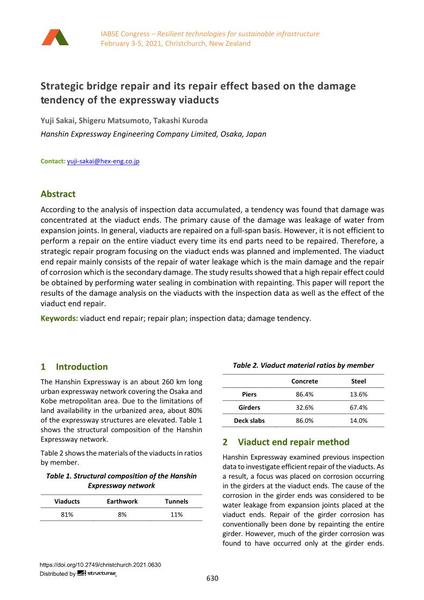Strategic bridge repair and its repair effect based on the damage tendency of the expressway viaducts

|
|
|||||||||||
Détails bibliographiques
| Auteur(s): |
Yuji Sakai
(Hanshin Expressway Engineering Company Limited, Osaka, Japan)
Shigeru Matsumoto (Hanshin Expressway Engineering Company Limited, Osaka, Japan) Takashi Kuroda (Hanshin Expressway Engineering Company Limited, Osaka, Japan) |
||||
|---|---|---|---|---|---|
| Médium: | papier de conférence | ||||
| Langue(s): | anglais | ||||
| Conférence: | IABSE Congress: Resilient technologies for sustainable infrastructure, Christchurch, New Zealand, 3-5 February 2021 | ||||
| Publié dans: | IABSE Congress Christchurch 2020 | ||||
|
|||||
| Page(s): | 630-637 | ||||
| Nombre total de pages (du PDF): | 8 | ||||
| DOI: | 10.2749/christchurch.2021.0630 | ||||
| Abstrait: |
According to the analysis of inspection data accumulated, a tendency was found that damage was concentrated at the viaduct ends. The primary cause of the damage was leakage of water from expansion joints. In general, viaducts are repaired on a full-span basis. However, it is not efficient to perform a repair on the entire viaduct every time its end parts need to be repaired. Therefore, a strategic repair program focusing on the viaduct ends was planned and implemented. The viaduct end repair mainly consists of the repair of water leakage which is the main damage and the repair of corrosion which is the secondary damage. The study results showed that a high repair effect could be obtained by performing water sealing in combination with repainting. This paper will report the results of the damage analysis on the viaducts with the inspection data as well as the effect of the viaduct end repair. |
||||
